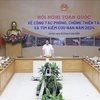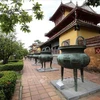The Ministry of Transport and authorities in Hanoi have agreed not to adopt a plan to rebuild the historic Long Bien Bridge, which has caused controversy among the public in recent days.
The bridge would only be upgraded to increase its traffic capacity, said Deputy Director of the municipal Transport Department Nguyen Xuan Tan at a press briefing on February 18.
The ministry had earlier proposed three plans. The first was to build a new bridge exactly where the old one stands, keeping the central part with the railway track intact, and removing other parts of the bridge for preservation.
The second option was to build a new, modern bridge with a similar design to the old one, and the third was to modernise the bridge while retaining parts of the central section and trusses.
The 2,290-m Long Bien Bridge was built between 1899 and 1902 by the French, and opened to traffic in 1903.
As the only bridge across the Red River that connected Hanoi to the highway leading to the northern port city of Hai Phong, the bridge played a crucial role in many important events in the country's history, including the independence wars.
It was heavily bombarded during the American War and became a symbol of defiance against aggression. It is no exaggeration to say that the bridge is an intrinsic, indispensable part of Hanoi's history and folklore, inspiring poets and musicians through generations.
Prominent experts and intellectuals have weighed heavily against the Transport Ministry's proposals.
"The bridge, while serving as transport infrastructure, is a cultural heritage that should be treated with care like any object of cultural preservation," Professor Hoang Dao Kinh, member of the National Cultural Heritage Committee, told the Thanh Nien (Young People) newspaper, adding that the originality of the bridge should be given absolute respect.
He said that "any interference", such as expanding the size or height, changing the original structure, shape or painting colours, can blight the beauty of the bridge, cause it to lose its originality and also its historical value.
Kinh said Hanoi has had newer bridges crossing the Red River, like Chuong Duong, Thang Long, Thanh Tri, or Vinh Tuy, but these bridges only serve the purpose of transportation and do not possess any special cultural value.
"With its position becoming more and more central in Hanoi, the bridge helps beautify the landscape around the river," he said.
Architect Tran Viet Thang of the Hanoi Architectural Planning Department is also of the opinion that the bridge should not be tampered with in any way.
However, he told Vietnam News that city leaders have "their own headache" on the issue.
Thang said the development of Hanoi, with the expansion of urban areas and the problem of traffic congestion, definitely requires a new bridge.
Yet it would be very difficult to build a whole new bridge because of the difficulties involved in land clearance and the high cost of building one with a new railway track, he noted.
Thang said there are ways to modernise a heritage site by adding new elements to it without ruining its original aesthetics, and some countries had managed to do this with their iconic sites.
However, this work has to be subtle and, given Vietnam's limited preservation capabilities, it is best to keep the bridge as it is now, Thang said.-VNA
The bridge would only be upgraded to increase its traffic capacity, said Deputy Director of the municipal Transport Department Nguyen Xuan Tan at a press briefing on February 18.
The ministry had earlier proposed three plans. The first was to build a new bridge exactly where the old one stands, keeping the central part with the railway track intact, and removing other parts of the bridge for preservation.
The second option was to build a new, modern bridge with a similar design to the old one, and the third was to modernise the bridge while retaining parts of the central section and trusses.
The 2,290-m Long Bien Bridge was built between 1899 and 1902 by the French, and opened to traffic in 1903.
As the only bridge across the Red River that connected Hanoi to the highway leading to the northern port city of Hai Phong, the bridge played a crucial role in many important events in the country's history, including the independence wars.
It was heavily bombarded during the American War and became a symbol of defiance against aggression. It is no exaggeration to say that the bridge is an intrinsic, indispensable part of Hanoi's history and folklore, inspiring poets and musicians through generations.
Prominent experts and intellectuals have weighed heavily against the Transport Ministry's proposals.
"The bridge, while serving as transport infrastructure, is a cultural heritage that should be treated with care like any object of cultural preservation," Professor Hoang Dao Kinh, member of the National Cultural Heritage Committee, told the Thanh Nien (Young People) newspaper, adding that the originality of the bridge should be given absolute respect.
He said that "any interference", such as expanding the size or height, changing the original structure, shape or painting colours, can blight the beauty of the bridge, cause it to lose its originality and also its historical value.
Kinh said Hanoi has had newer bridges crossing the Red River, like Chuong Duong, Thang Long, Thanh Tri, or Vinh Tuy, but these bridges only serve the purpose of transportation and do not possess any special cultural value.
"With its position becoming more and more central in Hanoi, the bridge helps beautify the landscape around the river," he said.
Architect Tran Viet Thang of the Hanoi Architectural Planning Department is also of the opinion that the bridge should not be tampered with in any way.
However, he told Vietnam News that city leaders have "their own headache" on the issue.
Thang said the development of Hanoi, with the expansion of urban areas and the problem of traffic congestion, definitely requires a new bridge.
Yet it would be very difficult to build a whole new bridge because of the difficulties involved in land clearance and the high cost of building one with a new railway track, he noted.
Thang said there are ways to modernise a heritage site by adding new elements to it without ruining its original aesthetics, and some countries had managed to do this with their iconic sites.
However, this work has to be subtle and, given Vietnam's limited preservation capabilities, it is best to keep the bridge as it is now, Thang said.-VNA



















